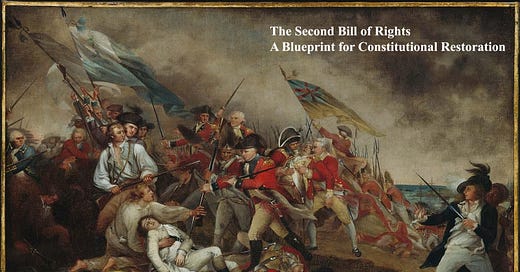"The Second Bill of Rights: A Blueprint for Constitutional Restoration"
To be published on July 4, 2026
"My Declaration of Intent"
“When in the course of human events, the meaning of a Constitution is lost not by revolution, but by reinterpretation, it becomes necessary for someone to draft a blueprint to restore it . . . ”
On this day 249 years ago, revolutionaries issued a Declaration. A year from today, I intend to do the same.
This project began while I was in law school and business school, as a response to the creeping collapse of constitutional restraint. It went dormant between 2016 and 2025—a time when the administrative state deepened its roots while public trust cratered. Now, the work resumes not with urgency, but with resolve. Because the need for restoration has not diminished. It has matured.
During all those years—even before this book took form—I found myself returning to the same historical thought experiment, often shared aloud with friends and colleagues:
Where are we now, relative to 1776 and 1861?
What might have been the current equivalent of the 1761 Writs of Assistance?
Are we living through the time of the Stamp Act’s provocation beginning in March 1765?
Are we in the pamphlet years between 1764 and 1776?
The time of the Boston Tea Party on December 16, 1773?
The Missouri Compromise moment beginning in 1820, where uneasy legislative fixes forestalled deeper rupture?
The Nullification Crisis phase of 1832–1833?
The slow Kansas-Nebraska drift and "Bleeding Kansas" period between 1854 and 1859?
After the ruling in Dred Scott v. Sandford was issued on March 6, 1857 making the future unmistakable?
Or, are we on the very precipice of the Battles of Lexington and Concord on April 19, 1775, or South Carolina’s secession from the Union on December 20, 1860?
It was a parlor game at first. But as the years have passed, the answers have grown more serious. The questions stopped being academic. They became predictive.
In both eras, the most clear-eyed voices saw what was coming long before the shooting began:
James Otis Jr. warned in 1761 that the Writs of Assistance would “totally annihilate” liberty.
Patrick Henry declared on March 23, 1775 that the Revolutionary War had already begun.
Thomas Paine closed the door on debate on January 10, 1776.
John C. Calhoun said as early as 1850 that the Union could not survive without preserving Southern “rights.”
Abraham Lincoln told us time and again in the mid-1850s the house couldn’t stand.
Frederick Douglass reminded us in 1857 that power concedes nothing without a demand.
William H. Seward saw the irrepressible conflict clearly in 1858.
In recent years, the warnings are coming again and more frequently—not just from the fringe, but from generals, scholars, and former insiders:
Complexity scientist Peter Turchin predicted a breakdown in the 2020s a decade ago.
Conservative essayist and member of both Trump administrations Michael Anton framed the 2016 and 2020 elections as existential turning points, warning that ruling elites are closing all peaceful paths to reform.
Stuart Rhodes, founder of the Oath Keepers, declared in 2020 that “we aren't getting through this without a civil war.”
Neoconservative and anti-Trump columnist Robert Kagan in 2021 asserted that a “constitutional crisis [is] already here.”
Lt. Gen. Michael Flynn (ret.) flirted with the idea of a military coup in 2021.
Leftist political scientist professor Barbara F. Walter said in 2022 that the U.S. now fits the profile of a country on the verge of civil war.
Canadian author Stephen Marche, writing from a distinctly left-leaning perspective in The Next Civil War published in 2022, outlined a series of speculative scenarios for American internal conflict—some more ideological than analytical—but even his work reflects a growing consensus: the center is not holding.
We remember revolutions only after they explode. But long before the first shot, there were speeches, essays, and pleas—ignored.
For decades, I’ve been working on a blueprint—a constitutional restoration framework—designed to reverse the drift that’s hollowed out our American Republic.
Exactly one year from today, I plan to release it.
It will not be partisan.
It will not be incremental.
It will be structural—a path to reclaim the original meaning and integrity of our Constitution in a way that is principled, and permanent.
We are not doomed to repeat the worst of our history. But we are required to learn from it.
If there’s still time to repair the foundation, we must do it boldly—and soon.
That’s my intent.
I’d love to hear your thoughts. Like, comment, and repost—fan the flames of this conversation!
Image used here is The Death of General Warren at the Battle of Bunker Hill by John Trumbull. Check it out the next time you're in Boston at the Museum of Fine Arts.





This sounds fantastic! Can't wait to read it.
The rise of managerialism has done more to erode the power and liberty of the constitution than any charismatic leader or political movement. If you would prevent a guaranteed return to the present pass in some distant future, you absolutely must include provisions against the rise of a large entrenched and unelected bureaucracy to systematize, normalize, and “manage” human beings according to non-human or even just blank-slate standards. HBD may be unseemly, disagreeable, and regrettable, but it is human nature and it is not going away. Please keep this in mind.
Also, all the rights in the world imputed to ourselves means nothing at the end of the day without enforcement clauses. Put teeth in the bill, with criminal penalties and imprisonment or even execution for violations of the rights therein enshrined. This was left out of the original, and it has suffered much for it. Punishment for even attempting to abrogate these rights will go a long way toward keeping them inviolate.